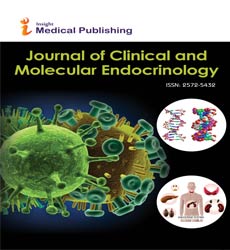Malignant Growth Treatment with Gene Therapy and Radiation Therapy
Mansa Veena J*
Indira Gandhi Medical College, Shimla, India
- Corresponding Author:
- Mansa Veena J
Indira Gandhi Medical College
Shimla, India
Tel: 0753426789
E-mail: mansa.j@yahoo.com
Received: October 26, 2021; Accepted: November 09, 2021; Published: November 16, 2021
Citation:Mansa Veena J (2021) Malignant Growth Treatment with Gene Therapy and Radiation Therapy. J Clin Mol Endocrinol. 2021, 6:6.61
Introduction
Notwithstanding, nearby repeat and far off metastasis regularly happen following radiation treatment for the most part because of the improvement of radio resistance through the liberation of the cell cycle, apoptosis, and hindrance of DNA harm fix systems. Throughout the last decade, broad advancement in radiotherapy and quality treatment combinatorial methodologies has been accomplished to defeat opposition of cancer cells to radiation.
Introduction
Radiation treatment approaches utilize ionizing radiation conveyed either remotely by straight gas pedals or X-beams and γ-beams or inside with the utilization of radioisotopes to obliterate disease cells. Radiation treatment is, by and large, confined, non-invasive and doesn't create fundamental harmfulness later therapy in correlation with chemotherapy. In any case, regardless of progress in radiation treatment, advancement of protection from remedial portions of illumination actually stays a significant hindrance for anticancer treatment. There are for the most part two significant types of obstruction experienced in clinical practice. One is natural radiation opposition, which is an intrinsic property of the malignant growth cells [1]. The other is obtained opposition, which creates ensuing to radiotherapy. It is turning out to be more apparent from clinical investigations of regular radiotherapy that multimodality treatment methodologies have a higher likelihood of coming out on top, probably in light of the fact that joined treatments all the while use assorted objective flagging pathways in cancer cells and may have non-covering poison levels. To beat instruments of radiation opposition, bringing about repeat of infection, procedures including a mix of radiation treatment and quality treatment have been widely explored [2].
Notwithstanding immediate DNA harm, light triggers an assortment of injuries in cell macromolecules (e.g., lipid peroxidation) to a limited extent due to mitochondria-subordinate age of responsive oxygen species (ROS). This complex of DNA and non-DNA injuries can invigorate different sign transduction pathways (like protein kinase C (PKC), JNK, ceramide, and MAPK enactment). Accordingly, the phone reactions to radiationintervened DNA harm are portrayed by facilitated processes including DNA fix systems drew in with different occasions that are happening in the cell, including cell cycle movement or apoptosis. At first, the harm to DNA starts flagging pathways that stop cell cycle movement through G1, intra-S, and G2/M to forestall move of DNA harm to offspring cells. Initiation of the DNA fix apparatus is worked with by expanded openness of DNA harm locales [3].
The two significant pathways engaged with DSB fix are homologous recombination (HR) and non-homologous end joining (NHEJ). The essential capacity of HR is to fix DSBs at the replication fork, though NHEJ is the critical instrument of DSB fix during G0, G1, and early S stage, and NHEJ keeps on fixing a minority of breaks during late S and G2 periods of the phone cycle.
A developing assemblage of proof recommends that a control of qualities associated with growth movement and radiation obstruction addresses a promising methodology for helpful intercession in mix with radiation treatment. Disease quality treatment is the particular exchange of recombinant DNA/ RNA utilizing viral and nonviral quality conveyance vectors, into dangerous cells just as growth related cells for helpful purposes. By and large, quality treatment approaches depend on the work of hereditarily designed vectors that advance the exchange of the transgene articulation unit into the cancer cells and permit transient or stable articulation of the helpful quality. The quest for strategies to bring qualities into malignant growth cells prompted many advances in viral and nonviral vector improvement [4].
Conclusion
Right now, human and nonhuman Ad vectors have been adjusted widely and are ordinarily utilized vectors in clinical preliminaries of malignant growth quality treatment. Promotions can transduce both partitioning and quiet cells. Conversely, with parvoviruses and retroviruses, Ads don't coordinate into the cell genome and accordingly represent no danger of insertional mutagenesis. Assistant ward high-limit Ad vectors are totally without all popular coding successions yet hold the viral ITRs and the bundling signal and were shown to be fundamentally more secure in correlation with the original of Ad vectors.
References
- Andreassen PR, Ho GP, Dïÿý??Andrea AD. (2006) DNA damage responses and their many interactions with the replication fork. Carcinogenesis 27:883ïÿý??892.
- Atkinson G, Hall SJ. (1999) Prodrug activation gene therapy and external beam irradiation in the treatment of prostate cancer. Urol 54:1098ïÿý??1104.
- Bjornsti MA, Houghton PJ. (2004) The TOR pathway: A target for cancer therapy. Nature Reviews Cancer 4:335ïÿý??348.
- Chen GG, Sin FL, Leung BC, Ng HK, Poon WS. (2005) Glioblastoma cells deficient in DNA-dependent protein kinase are resistant to cell death. J Cellular Physiol 203:127ïÿý??132.
Open Access Journals
- Aquaculture & Veterinary Science
- Chemistry & Chemical Sciences
- Clinical Sciences
- Engineering
- General Science
- Genetics & Molecular Biology
- Health Care & Nursing
- Immunology & Microbiology
- Materials Science
- Mathematics & Physics
- Medical Sciences
- Neurology & Psychiatry
- Oncology & Cancer Science
- Pharmaceutical Sciences
